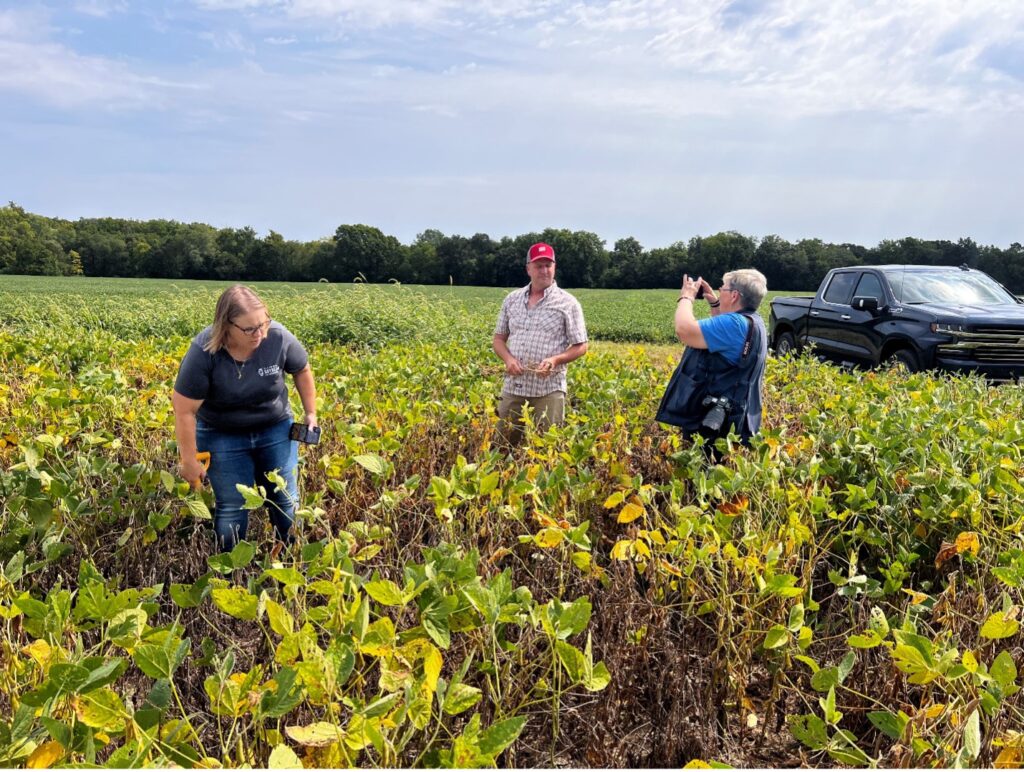In September, Abigail Peterson, Illinois Soybean Association (ISA) Director of Agronomy, and I were able to visit a Pike County farm near Pittsfield, Illinois, that had been plagued with red crown rot for the last 5 years. We were invited to look at a field of soybeans that were primarily infected with the pathogen, Calonectria ilicicola, which causes red crown rot. However, sudden death syndrome as well as stem canker were also found, infecting the soybeans as if they wanted to join the red crown rot party.
Soybean yield loss as great as 50 percent or higher has been observed in this region due to red crown rot, but yield loss will greatly depend upon on the presence of pathogen, environment, drainage, variety susceptibility, presence of soybean cyst nematode (SCN), and crop rotation. You truly cannot describe the devastation of some of the fields plagued with red crown rot until you drive down a road or stand in an affected soybean field in rural Pike County.

Soybean field in Pike County, IL infected with the pathogen that causes red crown rot during September of 2023.
Since then, previous research papers about Calonecria crotalarieae, another causal pathogen of red crown rot, have been shared amongst our agronomy team. One was an LSU Historical Dissertation and Thesis, entitled, “Distribution and Management of and Soybean Resistance to Calonectria crotalariae, the causal pathogen of red crown rot of soybean.” I encourage you to read it for an interesting historical perspective on this disease. For those that don’t know, Calanectria crotalariae was first detected on peanuts in 1966 in Georgia causing the disease known as black root rot. Later in 1972, this pathogen was found to cause disease on soybean and was called red crown rot as well as other names such as Cylindrocladium black rot and black root rot. I believe an often-overlooked fact is the pathogen of red crown rot or Calanectria crotalariae can infect many other plants besides soybean such as peanut, papaya, koa, blueberries, and indigo. In fact, this pathogen is thought to have been introduced in the United States to indigo ((Indigofera tinctoria (L.)) crop plantations through floodwaters and human activity. In 1976, it spread to 17 soybean-producing parishes in Louisiana. Several recognized (such as alfalfa and peanuts) and unidentified plant species within Illinois could potentially serve as alternate hosts for Calonectria ilicicola, the red crown rot pathogen.
Since there still are so many unanswered questions about this disease, the ISA Agronomy team has started a “meeting of the minds” of several plant pathologists, consultants, and researchers to discuss current red crown rot research and management updates, as well as observations that could lead to future research projects to combat this disease. During one of those meetings, we were made aware of a new document – University of Kentucky Plant Pathology Fact Sheet, called Red Crown Rot of Soybean. This article gives a great introduction of red crown rot as well as a guide to symptoms, signs, and disease management.
As for current management recommendations for red crown rot, first and foremost, one would want to improve field drainage. When it comes to the disease triangle, water is key for this disease to flourish once it makes its way to your field. Once the disease is established and builds over the years, it may be recommended to rotate to a non-host for at least two years to reduce disease inoculum. Currently, growers should pay attention to soil temperatures at planting and not necessarily the planting date. Why? Because the red crown rot pathogen that infects soybeans at planting prefers soil temperatures of 77F and 86F; therefore, planting into cooler soils could help reduce red crown rot infection. Hopefully, we will be able to continue to dive into these details further as we continue to collect multiyear data. The seed treatment, Saltro, now has red crown rot on its label, but it is not a stand-alone treatment. Free Testing and management of SCN is encouraged because this pest can intensify the effect of red crown rot as well as other diseases. Currently, some companies are trying to screen soybean varieties for differing levels of susceptibility to red crown rot, but so far, no soybean is completely resistant to this disease. Lastly, to our current knowledge, foliar fungicides have not been effective at managing red crown rot.
Stay tuned for more updates on a map of counties with soybeans that have been confirmed with red crown rot as well as a multi-state leading red crown rot publication from the Crop Protection Network (CPN). For now, our biggest battle to overcome is awareness of this disease and the proper identification of red crown rot of soybeans not only in Illinois, but throughout the Midwest.




 and then
and then